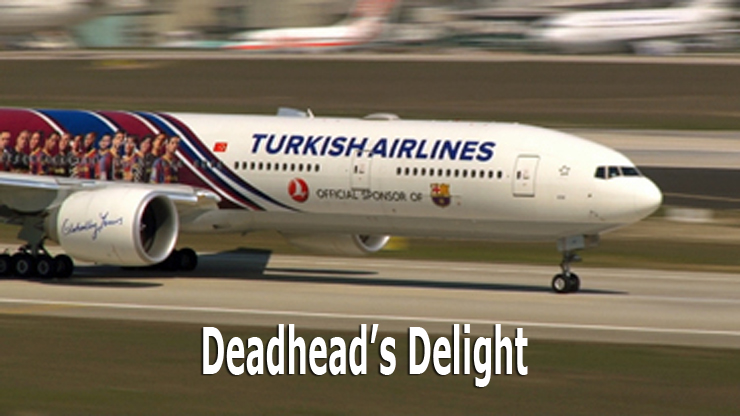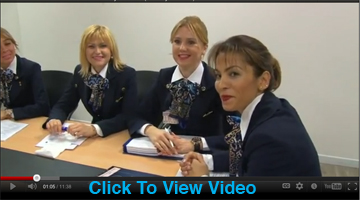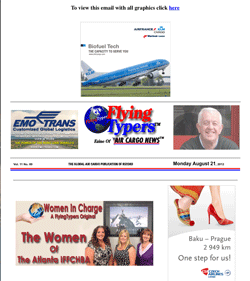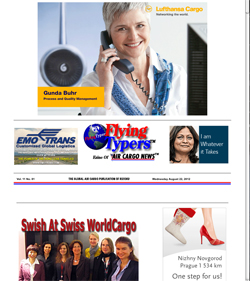 |
 |
|
| |
||
|
Vol. 11 No. 83 Wednesday August 29, 2012 |
|
Patrick
Murray talks about innovation
and building fast-growing
Calogi with great enthusiasm
and hope.
|
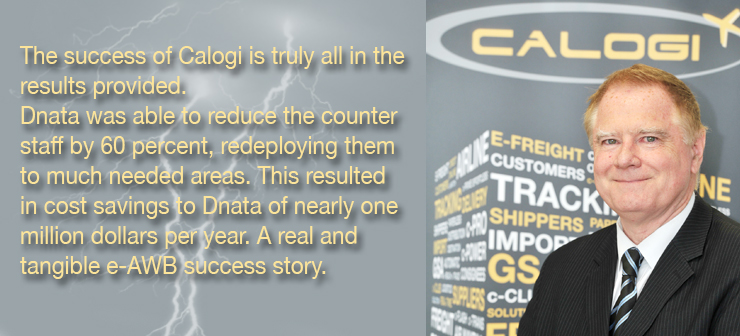 |
Despite
a downturn in DXB traffic,
Calogi has increased its membership
and transactions by over 28
percent—and 2012 is
looking even better with transactions
and membership increasing
by 15% in the first 6 months.
Calogi
is looking to expand its influence
beyond Dubai to offer cost-effective
e-freight solutions to others
looking for high-value answers.
“We
have already identified our
target markets and are working
on a penetration strategy.
Currently we have 5 distribution
partners in different parts
of the world and the aim is
to have a global network of
resellers by next year. If
we have got it right, and
the indications and feedback
from our surveys suggest we
have, we could see the number
of subscribers and transactions
double in the short term,”
says Mr. Murray.
While
he remains mum on all the
current developments Calogi
has to help customers increase
their business, there are
certain ideas he will share:
“I
am still keen to see an innovative
security solution whereby
an x-ray image of the shipment,
from a trusted source, can
be made available, through
Calogi, for inspection by
Customs at the destination,
prior to aircraft loading.
“The
Customs inspection at the
destination can then choose
to allow the shipment to be
accepted for import or not.
I think this could resolve
a number of issues.”
The
ideal thing would be to “replicate
the Dubai business model at
other airports,” but
Mr. Murray knows “this
may not be possible in the
first year.”
“It’s
all going to be about implementing
change. We would still like
to see a world where air cargo
supply chain stakeholders
can implement 100 percent
e-freight penetration and
remove all paper forms, not
just those that travel with
the freight, such as Airline/
Ground Handling Invoices,
Statement of Accounts, Airlines
Sales Reports, Agents Sales
Reports, Stock Reports, Shippers
Letter of Instruction, Charges
Correction Advices, the Air
Waybill and the House Air
waybill,” says Mr. Murray.
This will be Calogi’s
most difficult task given
all the different regulatory
hoops that must be jumped
through in order for everything
to work effectively.
Lufthansa
just sold its interest in
TRAXON, which makes us wonder
why owning an IT group is
a good thing, but Mr. Murray
assures us that Calogi is
not so much an IT group as
it is a “supply chain
solutions provider.
“I
am aware that some strategists
believe that airlines should
focus on their core business
of flying passengers, while
other are happy to diversify
into new businesses to spread
the financial risk and increase
revenues.
“We
do not believe in staying
in a comfort zone and have
taken the latter approach.
“You
can only imagine the challenges
we faced in the early days
as we developed and implemented
a new generation community
system that increases productivity
and addresses the needs of
each supply chain stakeholder,”
said Mr. Murray.
Moving
the Dubai model elsewhere
may seem like a smooth and
easy business, but only for
those with little knowledge
of the initial challenges
Calogi faced in Dubai.
“Less
than 30 percent of shipments
were processed through automated
means. Around 380 forwarders
did not have an IT solution.
“The
cargo terminals captured AWB
data manually as part of the
acceptance process.
“Dnata
staff also spent a large proportion
of time handling cash and
issuing receipts. 120 full-time
staff were manning the export
counters and resolving disputes
over airline contracts, ad-hoc
and rack rates. (The 120 full-time
staff cover the seven cargo
facilities operated by dnata
in DXB and Dubai World Central
Airport).
Of
all the issues with implementing
an efficient IT system in
Dubai, five stood out to be
the most egregious.
“Airlines
could only do business with
a limited number of large
forwarders; the Dubai air
cargo industry ran on paper,
(with) several documents required
to move a shipment from A
to B; ad-hoc rate slips were
handwritten, (which) often
led to disputes (that) took
a long time to resolve (and
also meant) confidentiality
could not be guaranteed, and
airline published rates distributed
via letter and fax led to
late implementation and loss
of revenue; air waybill stock
was distributed via email
and airlines relied on the
forwarder or GHA to manage
the usage, (which meant) no
one knew the status of the
shipment until it arrived
in the warehouse,” said
Mr. Murray.
In
2009, Calogi implemented their
changes in the Dubai community,
with many positive results.
Small freight forwarders could
now do business on a larger
scale for less money, with
the Calogi system allowing
them to “auto-rate and
execute master house air waybills,
interface with airlines and
the GHA, and track shipments
on the portal.” Gone
were the cash transactions
and offline invoicing and
payments; with Calogi, each
forwarder had a credit account
intermediary and could track
the status of their accounts
in real time.
“Calogi’s
unique ad-hoc air waybill
release feature enabled each
airline/GSA to do business
with all Calogi forwarders
in Dubai.
“The
airline made a pool of air
waybill stock available to
the community and each forwarder
had the option to assign an
air waybill to a particular
job. “Upon execution
of the air waybill, the monies
were deducted from the forwarders
Calogi credit account and
credited to the airline,”
said Mr. Murray. This system
also allowed the airline to
do business with the entire
Calogi community. Furthermore
in the above cases, the airline,
being the executing agent,
shared a portion of the air
waybill fee with the forwarder.
This created an additional
source of income for the airline
and benefited the forwarder
in that he paid a reduced
air waybill fee. These benefits
were a direct result of the
Calogi implementation.”
Where
once before an airline or
forwarder was left sending
and receiving stacks of paper,
now most paper documents were
digitized, including “Invoices,
Statement of Accounts, Airlines
Sales Reports, Agents Sales
Reports, Stock Reports, Instruction
for the Despatch of Goods,
Charges Correction Advices,
the Air Waybill and the House
Air Waybill.”
Airlines
and GSAs now assumed the responsibility
of maintaining and publishing
rates, with only the airlines
and forwarders being privy
to those rates, which reduced
the number of rate disputes
and improved confidentiality.
The
success of Calogi is truly
all in the results provided.
“Dnata
was able to reduce the counter
staff by 60 percent, redeploying
them to much needed areas.
This resulted in cost savings
to Dnata of nearly one million
dollars per year. A real and
tangible e-AWB success story.
“Calogi
settled over $9M USD in airline
dues in the first month of
operation. “The airline
also received $9 USD as his
share of og the air waybill
fee for each air waybill executed
from the pool of stock made
available to the community.
Not only did Calogi create
a financially risk free environment,
it also created a source of
income for airlines.
“Dubai
has the capability to become
a 100 percent e-freight station,
which will save the local
industry millions of dollars.
“Rate
disputes and revenue leakage
have almost disappeared.
“The
shipment and flight revenue
data are available instantaneously.
By having immediate access
to this data, airlines can
identify the source of revenue
shortfalls and develop strategies
to address the same,”
said Mr. Murray.
There
are many reasons air cargo
needs Calogi. By entering
data into an online ‘cloud,’
data need only be entered
once—it can be reused
infinitely and with complete
transparency. The absence
of paper creates a green solution
that is also cost-effective—there
are no expensive messaging
costs. Calogi is also “the
only system that unites the
major air cargo supply chain
stakeholders on one platform,”
said Mr. Murray.
“We
bring a new dimension to the
airfreight industry in the
form of credit management.
Distributing stock to a forwarder
is no longer like issuing
a blank check.
“Instead,
airlines can decide the amount
of financial risk they are
willing to take with each
forwarder by setting credit
limits.
“We
now have a number of contracts
signed with 3PL operators
who will be offering their
products and services to Calogi
stakeholders. Once again,
they are able to control the
amount of credit offered and
defer to the Calogi account
if they would like to transfer
the risk.
“We
offer small airlines, GSAs
and forwarders the opportunity
to ‘brand’ Calogi
as their own web site. Users
logging on will be directed
to the airlines, GSA’s,
or forwarder’s branded
version of Calogi.
“After
logging in the users will
only be able to access the
products and services offered
by that specific company,”
said Mr. Murray. Calogi is
essentially bringing an IT
solution to the air cargo
community the way eBay brought
a marketplace solution to
the small seller.
“For
a fraction of the price of
building, testing and supporting
a web site, smaller companies
can harness the rich functionality
of Calogi to distribute their
products to their customers.
“We
have not forgotten the Ground
Handling Agents (GHA) role
either. Calogi Forwarders
are able to share shipment
information with the Cargo
Terminal Systems, thus avoiding
the need for the GHA staff
to rekey data, allowing the
forwarder to bypass the terminal
counters and proceed directly
to the delivery dock with
his shipment.
“Prior
to delivering the cargo the
forwarder is able to book
an off-peak, normal or peak
dock slot using Calogi (This
feature is also available
for import shipments).
“Each
slot type is priced differently
to encourage the forwarder
to deliver/collect the shipment
during periods of low activity
(off-peak) to spread the terminal
workload and avoid congestion.
“Furthermore,
dnata shares its cost savings
with the agent community in
the form of preferential (discounted)
documentation and cargo handling
rates, a benefit which usually
outweighs the Calogi cost
by far.
“We
will continue to develop Calogi
to keep abreast of industry
standards and initiatives.
“We
have two philosophies: to
continue to support the industry
by developing and testing
features and make them available
on the portal, thus helping
our stakeholders to keep their
costs down, and to increase
our income by increasing the
volume of users and transactions,
thus keeping the price down.
“Even
an exporter who has one or
two shipments a week has found
our system extremely cost
effective,” said Mr.
Murray.
Geoffrey
Arend
When
in February of this year,
Brazil’s state-run airport
operator Infraero finally
gave up the ghost and sold
its gateway airports—in
Brasília, São
Paulo (Guarulhos), and Campinas
(Viracopos)—to the Brazilian
infrastructure group Invepar
(Concessionária Aeroporto
Internacional de Guarulhos)
for R24.5 billion, hope ran
high that change would be
immediate at the airports
that have been described as
“nightmarish.” |
Get
On Board Air Cargo News
FlyingTypers |
If
You Missed Any Of The Previous
3 Issues Of FlyingTypers |
|||||
|
|||||
FT082112 |
FT082712 |
||||
|---|---|---|---|---|---|



 Just
in case it got lost in translation,
or you’re too busy muddling
through what has turned out
to be a business year of survival,
the TSA deadline for 100 percent
screening of all passenger
flights carrying cargo into
USA goes into effect on December
3, 2012—about 120 days
from now.
Just
in case it got lost in translation,
or you’re too busy muddling
through what has turned out
to be a business year of survival,
the TSA deadline for 100 percent
screening of all passenger
flights carrying cargo into
USA goes into effect on December
3, 2012—about 120 days
from now.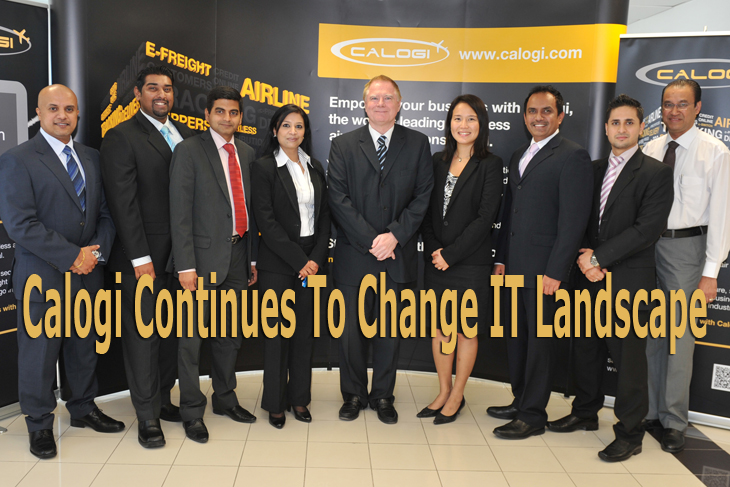

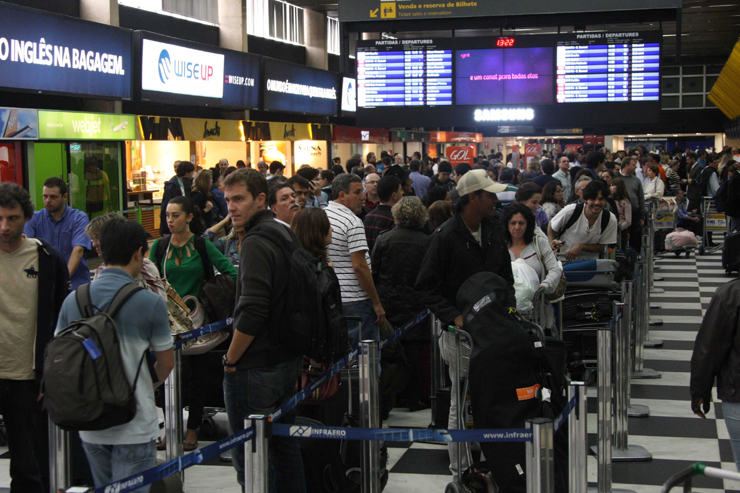 Another
Day in Paradise? Airport
officials in Sao Paulo
hope to avoid this
scene so typical today,
when World Cup comes
to town in 2014.
Another
Day in Paradise? Airport
officials in Sao Paulo
hope to avoid this
scene so typical today,
when World Cup comes
to town in 2014. So
now with the new owners having
taken command a few weeks
ago and now in the driver’s
seat (or cockpit), expectations
have come back down to earth
regarding any quick turnaround,
although promised expansion
and modernization projects
are at last report about to
get underway.
So
now with the new owners having
taken command a few weeks
ago and now in the driver’s
seat (or cockpit), expectations
have come back down to earth
regarding any quick turnaround,
although promised expansion
and modernization projects
are at last report about to
get underway.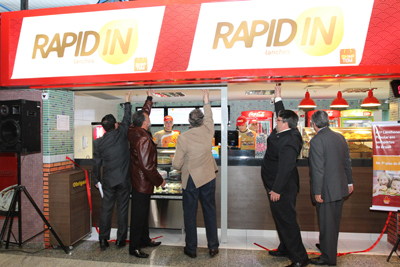 Elsewhere,
Concessionária has
set the March 2014 deadline
for completion of the first
phase of improvement work
slated for Guarulhos—four
months before World Cup begins.
Elsewhere,
Concessionária has
set the March 2014 deadline
for completion of the first
phase of improvement work
slated for Guarulhos—four
months before World Cup begins.